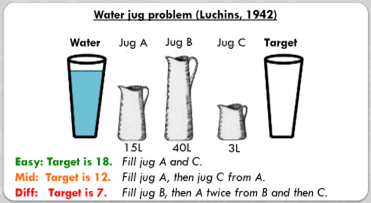Reasoning and Decision Making - Lecture 1
1/16
There's no tags or description
Looks like no tags are added yet.
Name | Mastery | Learn | Test | Matching | Spaced |
|---|
No study sessions yet.
17 Terms
Gestalt Approach - Representational Restructuring
solve problem by restructuring it - because we encounter a block when represented in the wrong way (Ohlsson, 1992).
doesn’t explain how brain is involved in solving problems.
Gestalt Approach - Insight
the point at which solution is suddenly seen/problem becomes clearer.
argue insight caused by sudden restructuring. may not be separate cognitive process - only aware of solution once certain threshold crossed.
Gestalt Approach - Functional Fixedness
ideas about object function interferes with using object more usefully e.g. Candle Problem (Duncker, 1949).
Adamson (1952) - 80% solved candle problem correctly if pin box was empty, versus 40% when not.
Luchins (1942) - Water Jug Problem
Ps who did easy problem first - 95% correct on mid-level problems.
Ps who did difficult problem first - 35% correct on mid-level problems.
evidence of insight - gradually reach threshold versus continuing to use strategy that may not be helpful.

Information Processing Approach (Newell & Simon, 1970s)
assumes problem solving is serial search process:
initial state → goal state → subgoals/intermediate states - we perform search of all possible choices.
methods for problem solving:
planning
heuristic methods
progress monitoring
Planning
Tower of Hanoi Problem - Ps spent longer planning moves performed better with fewer errors (Koppenol-Gonzalez et al., 2010).
limit on amount of planning we can engage in due to limitations in STM.
Heuristic Methods - Means-End Analysis
look for difference between current state and goal.
find action to reduce difference and perform it.
repeat until final goal achieved.
solves problem of limits to STM.
Progress Monitoring
track progress towards goal, switch strategy if progress slow.
performance worse if Ps think progress is being made. realise progress slow = more likely to switch strategies (MacGregor et al., 2001).
Evidence for information processing
Ps w/ damage to PFC perform worse on Tower of Hanoi than control Ps, particularly for moves which take them away from end goal (Goel & Grafman, 1995)
Kleibeuker et al. (2013) - Problem Solving
fMRI - adolescents and adults - matchsticks grid (remove 10 to create 2 squares).
response in lateral PFC - positively correlated with performance.
Qiu et al., 2010 - Insight
fMRI - neural activity correlated with insight during solving Chinese logographs.
activity in precuneus, left inferior/middle frontal gyrus, inferior occipital gyrus.
suggests areas related to memory retrieval, changing strategies, visual imagery, and attention.
Crescentini et al., 2012 - Planning
fMRI - look at regions involved in planning during problem solving of Tower of Hanoi task.
dlPFC - key area involved in initial planning more than memory.
Analogies
using the solution of one problem to guide the solution to a new, similar, problem.
Duncker’s Radiation Problem
high or low laser to kill tumour.
solved using fortress analogy - multiple low intensity lasers.
10% could solve no help
30% could solve hearing fortress story
75% solve being told two stories related
Explicit and Implicit Reasoning
implicit = fast, automatic, not always aware
medical experts largely utilise implicit reasoning - can lead to errors e.g. radiologists can fail to detect diseases in ~30% of cases (Krupinski, 2011).
Eye Tracking Studies
Krupinski et al. (2013) - breast biopsies - look less at non-diagnostic regions as expertise increased.
mammograms - more likely to identify cancer if make eye movement to the cancer in under 1s.
most experience = fixate on cancer quickest → use implicit process rather than serial search.
Chase & Simon (1973)
task - memorise location of chess pieces - randomly or in game positions.
experts → remember game positions better, not random. do not have overall better memory.
do this by chunking relevant information.